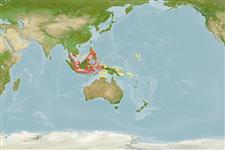>
Eupercaria/misc (Various families in series Eupercaria) >
Labridae (Wrasses) > Bodianinae
Etymology: Choerodon: Greek, choiros = a pig + odous = teeth (Ref. 45335); referrring to the prominent anterior canines of the species in this genus (Ref. 116605).
More on author: Bleeker.
Environment: milieu / climate zone / depth range / distribution range
Ökologie
seewasser riff-verbunden; tiefenbereich 2 - 15 m (Ref. 90102). Tropical; 20°N - 20°S, 95°E - 170°E
Western Central Pacific: Pulu Weh; Singapore; Bintang; Banka; Borneo (Balikpapan, Sandakan); Sulu Islands; Celebes (Makassar, Badjoa), Malacca, Philippines, New Caledonia.
Size / Gewicht / Alter
Maturity: Lm ? range ? - ? cm
Max length : 28.2 cm SL Männchen/unbestimmt; (Ref. 572)
Recognized by the bright white patch that is highly visible in dirty water (Ref. 48636). Colour orange with light grey longitudinal stripes, a large bright yellow oval spot on side above lateral line and below anterior half of dorsal fin. Subopercle with 6 to 10 scales, scales extending anteriorly at least to below midpoint on ventral preopercular edge. Pectoral fins with ii unbranched and 13 to 15 (rarely 15) branched rays. (Ref 9823)
Adults inhabit coral reef areas (Ref. 27550) in shallow inshore to deep water (Ref. 48636). Oviparous, distinct pairing during breeding (Ref. 205). Usually marketed fresh (Ref. 27550).
Life cycle and mating behavior
Geschlechtsreife | Fortpflanzung | Ablaichen | Eier | Fecundity | Larven
Oviparous, distinct pairing during breeding (Ref. 205).
De Beaufort, L.F., 1940. The fishes of the Indo-Australian archipelago. VIII. Percomorphi (continued). Cirrhitoidea, Labriformes, Pomacentriformes. E.J. Brill, Leiden. v.8:1-508. (Ref. 572)
IUCN Rote Liste Status (Ref. 130435)
Bedrohung für Menschen
Harmless
Nutzung durch Menschen
Mehr Information
ReferenzenAquakulturAquakultur ProfilZuchtlinienGenetikElectrophoresesVererbbarkeitKrankheitenVerarbeitungNutrientsMass conversion
PartnerBilderStamps, Coins Misc.LauteCiguateraGeschwindigkeitSchwimmstilKiemenoberflächeOtolithsGehirngrößeSehfähigkeit
Tools
Zusatzinformationen
Download XML
Internet Quellen
Estimates based on models
Preferred temperature (Ref.
123201): 27.1 - 29.1, mean 28.4 °C (based on 494 cells).
Phylogenetic diversity index (Ref.
82804): PD
50 = 0.5000 [Uniqueness, from 0.5 = low to 2.0 = high].
Bayesian length-weight: a=0.01318 (0.00582 - 0.02984), b=3.05 (2.86 - 3.24), in cm total length, based on LWR estimates for this (Sub)family-body shape (Ref.
93245).
Trophic level (Ref.
69278): 3.5 ±0.4 se; based on size and trophs of closest relatives
Widerstandsfähigkeit (Ref.
120179): mittel, Verdopplung der Population dauert 1,4 - 4,4 Jahre. (Preliminary K or Fecundity.).
Fishing Vulnerability (Ref.
59153): Low vulnerability (24 of 100).
